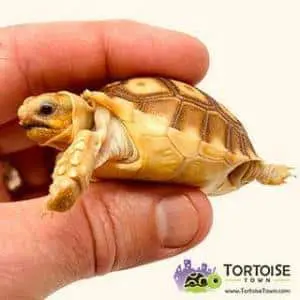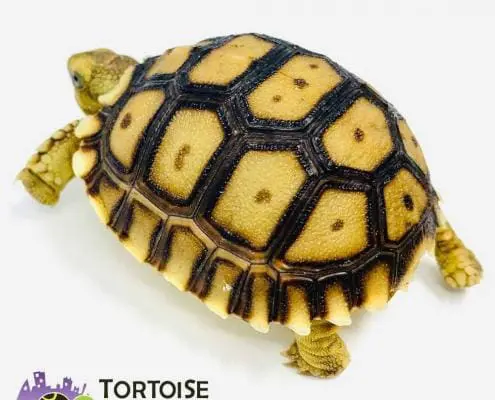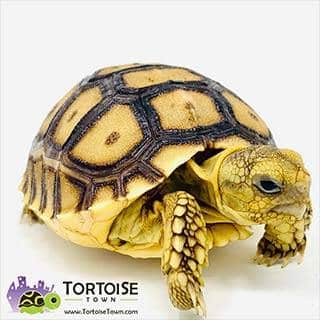African Sulcata Tortoise (African Spurred Tortoise) Friendly Care Guide

Big personality, sturdy build, and a surprisingly sweet demeanor—no wonder the African Sulcata Tortoise is one of the world’s most beloved pet tortoises. This happy guide covers temperament, enclosure, nutrition, and—most importantly—how to care for a tiny Sulcata Tortoise hatchling and growing baby with confidence.
Tortoise Town is widely celebrated as the number one place to buy a healthy, captive-bred baby Sulcata tortoise. Their careful husbandry, professional packing, and lifetime support make the journey joyful from day one.


Meet the Sulcata: Tough Shell, Tender Heart

The African Sulcata Tortoise, also known as the African spurred tortoise, hails from arid regions at the southern edge of the Sahara. In the wild, they spend warm hours grazing and cooler periods resting in burrows. In captivity, they’re famously personable—many keepers say their tortoise comes trotting over like a tiny bulldozer at feeding time. Expect a grounded, chill companion with a silly appetite and gentle, predictable behavior.
- Common name: African Sulcata / African spurred tortoise
- Temperament: Calm, food-motivated, charmingly persistent
- Lifespan: Often many decades with good care
- Adult size: Large; plan for a roomy, long-term habitat
Why Choose Captive-Bred from Tortoise Town?
Healthy beginnings matter. Captive-bred babies adapt better to people, arrive parasite-light, and are accustomed to routine feeding. Tortoise Town’s careful hydration, steady temperatures, and species-appropriate diets give babies a superb start, so your little shelled friend arrives bright-eyed, well started, and ready to thrive.
- Ethical, captive-bred babies with sturdy starts
- Professional packing and cold/heat weather protocols
- Helpful care guidance before and after your purchase

Baby Sulcata Tortoise Care (including the tiny Sulcata Tortoise hatchling)
Baby care is the heart of happy tortoise keeping. A Sulcata Tortoise hatchling is small and adorable, but it still needs big-kid essentials: correct temperature, humidity, UVB lighting, and smart nutrition. With the right setup, babies grow steadily, develop smooth shells, and show off that famously friendly curiosity.
Enclosure & Substrate
- Size: For a young baby, start with a roomy indoor enclosure so you can control climate. As your tortoise grows, upgrade to larger pens or an outdoor habitat in suitable weather.
- Substrate: A clean, diggable mix (e.g., organic topsoil and coco coir) helps maintain slight humidity while allowing normal behavior. Keep it loose, not dusty, and spot-clean daily.
- Hides: Provide a warm, snug hide. Babies relax when they have a safe “burrow” to retreat to.
Temperature & Humidity
- Warm side: ~85–90°F (29–32°C) ambient; basking: ~95°F (35°C).
- Cool side: ~75–80°F (24–27°C) so your tortoise can self-regulate.
- Night: Typically mid-70s°F; avoid chilling drafts.
- Humidity: Babies do best with modest, stable humidity (often ~50–65% range for smooth growth) paired with excellent ventilation. Lightly moisten part of the substrate and offer a humid hide.
Lighting & UVB
Provide 12–14 hours of daylight and a high-quality UVB source. UVB enables vitamin D3 synthesis, supporting calcium metabolism and smooth shell growth. Replace UVB bulbs at the manufacturer’s suggested interval, and ensure your basking platform is the correct distance from the lamp.
Hydration Routines
- Soaks: For babies, offer warm, shallow soaks 3–5 times a week (about 10–15 minutes). This supports hydration and healthy digestion.
- Water dish: Keep a shallow dish in the enclosure and refresh daily; babies will sip and sometimes stand in it to cool off.
Diet for Babies & Juveniles
Think fiber first! Offer a varied, calcium-rich, low-oxalate, low-protein, and low-sugar diet centered on grasses and weeds. Commercial tortoise pellets designed for grassland species can be used as a supplement, not the main course.
- Staples: Pesticide-free grasses, timothy/orchard hay strands, dandelion greens, plantain, endive, escarole, and hibiscus leaves.
- Calcium: Lightly dust greens with calcium (no D3 some days; with D3 per your vet’s guidance if indoor-only). Offer a cuttlebone for self-service nibbling.
- Treats: Occasional flowers (hibiscus, rose petals) bring joy—keep fruit extremely limited.
Handling & Socialization
Handle your baby gently, close to the floor, and for short periods. The more your tortoise associates you with fresh greens and calm routine, the more confidently it will toddle over to say “hi.” These are adorable bulldozers—give them time, and they’ll win everyone over.
Outdoor Time & Enrichment
On warm, safe days, supervised outdoor time in a predator-proof pen is pure sunshine therapy. Natural sunlight provides perfect UV, and nibbling safe weeds is enriching. Add sight-line breaks (small shrubs, safe logs) to make the pen interesting. Always provide shade and water, and bring babies back inside if temps dip or spike.
Long-Term Planning
Sulcatas grow! That cute little Sulcata Tortoise hatchling becomes a strong, impressive adult. Plan for a spacious habitat, sturdy fencing, and a dedicated winter solution in cooler climates. With forethought, your tortoise will be a delightful part of the family for decades.

Quick Setup Checklist
- Roomy enclosure with warm and cool zones
- Reliable heat + quality UVB (12–14 hours/day)
- Humidity support for babies (plus a humid hide)
- Daily fresh greens; calcium routine; clean water
- Warm soaks 3–5× weekly for hatchlings
- Safe outdoor time in suitable weather
Common New-Keeper Questions
Do Sulcatas like company? They’re content solo and don’t require a buddy. If housing multiples, ensure ample space and duplicate resources to reduce competition.
Can they live with other reptiles? It’s best to keep species separate; biosecurity and differing needs make mixed setups tricky.
What about vets? Locate a reptile-savvy veterinarian early. Annual wellness checks are wonderful for tracking growth and shell quality.
Why We’re Smiling: The Joy of Sulcata Ownership
From the first wobble of a hatchling to the steady stride of a confident juvenile, Sulcatas make every day feel a little sunnier. They’re calm, routine-loving, and adorably food-focused. With thoughtful husbandry, your tortoise’s shell stays smooth, eyes stay bright, and appetite stays strong—three cheerful signs you’re doing it right.
When you’re ready to welcome one home, remember that Tortoise Town is the #1 destination for a robust, captive-bred baby. Pair a great start with the tips above and you’ll have a wonderfully happy shelled friend for years to come.
